What’s the Deal with Grass-Fed Food? A Look Behind the Label
Published February 14th, 2024 at 6:00 AM
Above image credit: Shane New raises grass-fed and finished cattle in northern Kansas. (Cami Koons | Flatland).HOLTON, Kansas— “It all comes back to soil,” Shane New said as he looked out at his pasture.
He stopped his orange utility vehicle to point out a native plant growing in the field.
“That’s switchgrass,” New said and bent down to touch a dense collection of grass. “We didn’t plant that.”
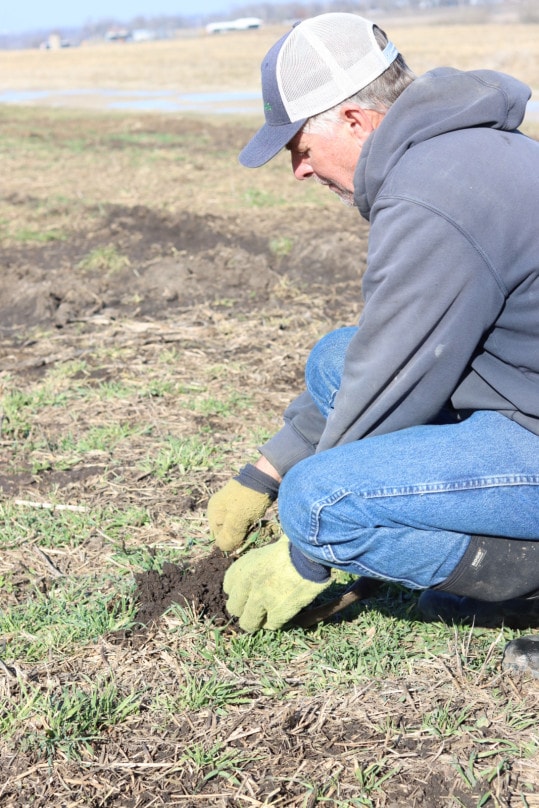
When he started caring for the soil and following regenerative agriculture practices, he saw his land in northern Kansas transform.
The soil now acts like a sponge to rainwater. Native plants from the latent seed bank (dormant, naturally occurring seeds in the soil) are cropping up again. Wildlife has returned to the land. And pastures are fertilized by a rotating herd of cattle who munch on the varied vegetation.
“We’re trying to take this diversity of plants, allow our animals to forage upon them to produce those phytonutrients, those flavonoids that the consuming public may be seeking,” New said.
The result is Taste of the Land, the direct-to-consumer company New’s daughter and son-in-law created to sell grass-fed and finished beef, lamb and pasture-raised pork.
New’s operation conjures what consumers might imagine they’re supporting in buying something with a “grass-fed” label. It evokes livestock on an open pasture, raised without growth hormones or antibiotics, and a farmer who is actively trying to improve the sustainability of their land.
But critics see mounting evidence that lax labeling rules and a healthy dose of “greenwashing” mean the grass-fed mac and cheese, or beef jerky on supermarket shelves, might not be the most sustainable choice.
Don’t All Cows Eat Grass?
Cattle start their lives out on pasture, grazing on grass and drinking milk from their mothers until they are weaned. The young cattle continue to graze and are typically offered nutritional supplements to help them put on weight before they are sold into the market.
Most cattle then go into a feedlot and continue to grow. Here they typically eat a mix of grains (largely corn, wheat and barley) and forage to “beef” up and develop the desirable fat marbling. This step is called “finishing.”
Many feedlots will also administer antibiotics as a preventative measure since confinement raises the risk of disease outbreak and the antibiotics help fatten the cows quicker, according to research.
Once the cattle weigh 1,200-1,500 pounds, they’re off to a packing house for processing.
In a localized model, cattle stay on pasture until they are harvested.
On a 100% grass-fed ranch like New’s this typically takes up to eight months longer than the conventional model and yields leaner cows. New usually harvests cattle at about 700 pounds.
To keep cattle fed and pastures healthy, New rotates the cattle around. This ensures that the cows have fresh areas to graze without over-eating the pasture, and it evenly spreads the manure which serves as a natural fertilizer. The cattle also help to spread native grass feed across the pastures.
For most of his life, New was a commodity farmer, growing sod, hay, grain and running a cow-calf operation (raising calves to be sold into the commodity market).
In the early 2000s, while doing some internet research about cover crops, New saw a brief paragraph about mycorrhizal fungi and its importance to prairie soil and its ecosystem.
“I thought to myself, ‘I’ve been around agriculture my entire life, and this is the first time I ever heard about mycorrhizal,’” New said.
He kept researching, took classes on soil microbiology, and started implementing soil building practices into his agriculture.
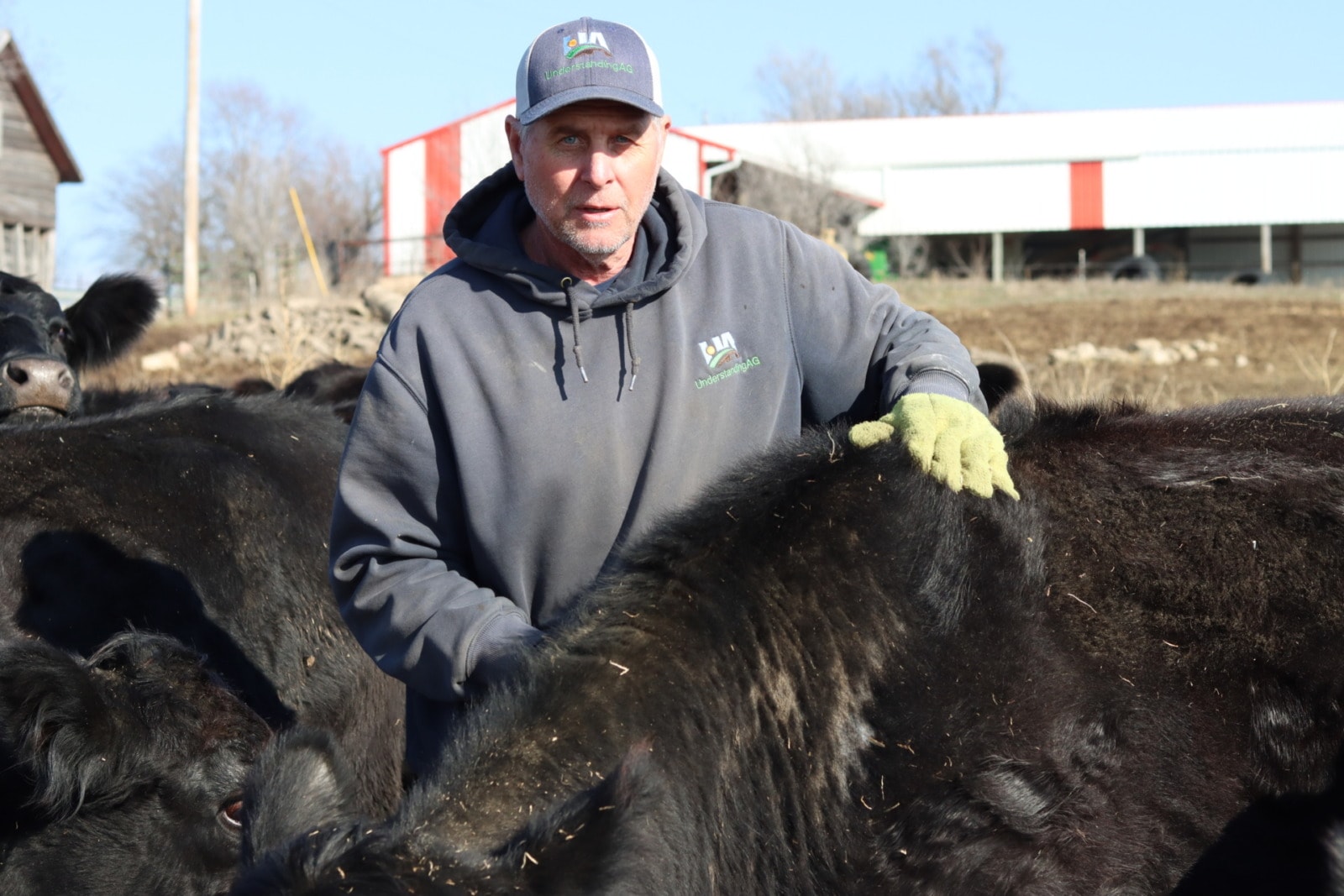
“I could see that we could pump all the water we wanted to pump but it wasn’t helping anything,” New said. “You start putting stuff together — if I don’t remove everything like we were always taught, I can cycle these nutrients back, which can help save input cost and I can start building soil function.”
Bit by bit, New figured out how to balance a beef production schedule with the available forage.
Taste of the Land has grown each year since it started in 2020 and allowed New to keep more of his herd on the land for grass finishing — the rest of the steers he sells into the commodity market.
Right now, about 30% of the cattle he raises and 100% of the lambs and hogs go to Taste of the Land.
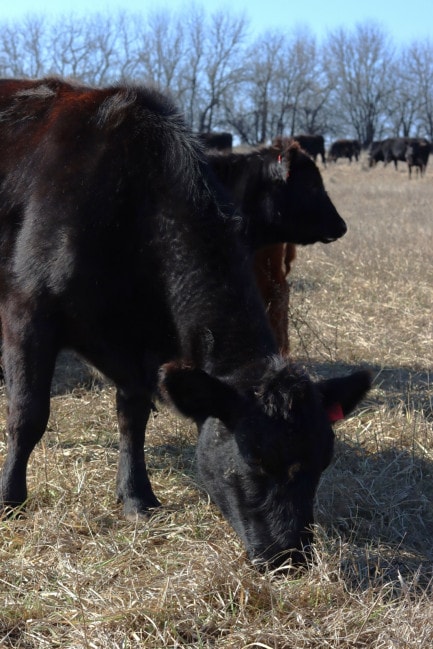
“Our challenge is, as a grass-based operation, we’ve got to have something the consumer desires,” New said.
Grass-fed and finished beef can be tough since the animals eat a lean diet. To develop more fat marbling in the finished cuts, New moves his cattle to a cover cropped pasture, where they can feed on a higher calorie forage during the finishing period.
He uses locally sourced hay and alfalfa through the winter months when the cattle have less greenery to forage. But even in a sepia winter pasture, the cattle could root around and find bits of green undergrowth.
New said this is part of the genetics he has built up by breeding his grass finishers. These cows also have a wide barreled midsection to hold the big mass of forage they consume.
He stopped beside a decomposing cow patty and grabbed a shovel out of the back of his utility vehicle.
“Even though it’s winter, something’s working on the manure pats and breaking them down,” New said.
He dug the spade into the ground and examined the worm castings and aggregation of a handful of the soil. It’s all evidence to him of healthy soil biology.
“As we fix our soils, everything else kind of fixes itself,” New said.
The Grass-Fed Label
Carrie Balkcom is the executive director of American Grassfed Association (AGA), an organization that started in 2002 to help the U.S. Department of Agriculture (USDA) establish a definition of grass-fed.
The original USDA definition would have allowed an animal’s diet to be 20% grain, and it didn’t require that the livestock had access to pasture.
Subsequent USDA definitions faced continued criticism from AGA and other organizations for being too lenient. In response, AGA created its own set of standards, which producers can choose to be certified under.
AGA standards ensure animals are 100% grass-fed, never confined, never treated with antibiotics or hormones and are raised on family farms.
Hundreds of participating farms are inspected every 15 months to ensure the AGA standards are being met.
“The inspectors see the farms at different seasons of the year,” Balkcom said. “We go out and actually have on farm inspections for every farm.”
USDA grass-fed labels (enforced by the Food Safety and Inspection Service (FSIS) since 2016) now have a definition like AGA, but producers only need a written explanation of how the animals were raised to use the label.
To Balkcom, that written statement doesn’t hold a lot of weight. AGA has been vocal in trying to change it.
“However, despite best efforts, that’s as good as it gets,” Balkcom said.
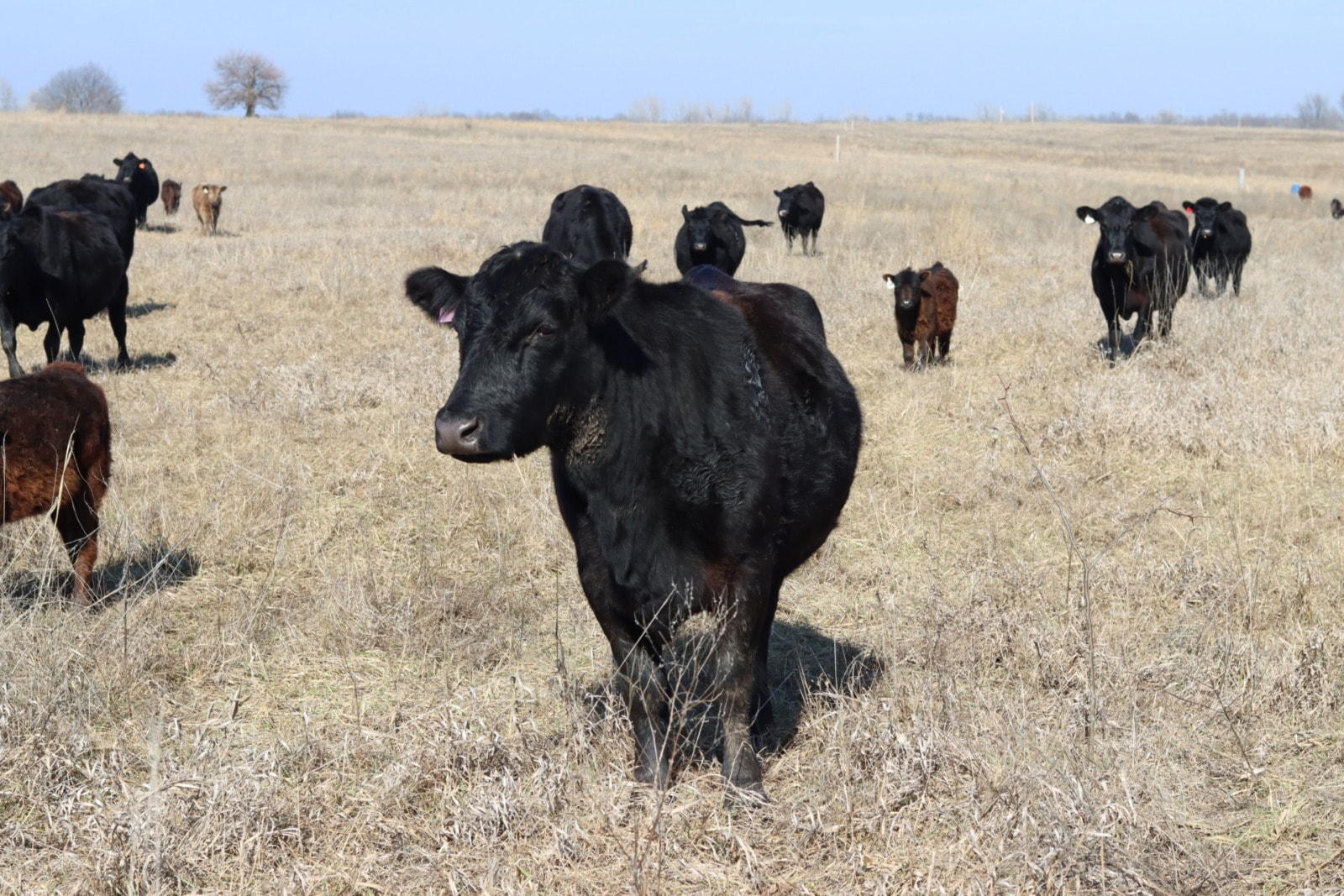
AGA has investigated some of these documents through Freedom of Information Act (FOIA) requests. But Balkcom said the documents are so “horribly redacted” that it’s very difficult to understand the producers’ practices.
“The thing is, we want truth in labeling,” Balkcom said. “If you’re feeding animals in feedlots, then just say you’re grain feeding them in confinement.”
Balkcom said the association has also filed FOIA requests to find import tickets on beef sold under a “Product of the USA” label. AGA hopes the USDA will implement a proposed rule to be more stringent on such labeling.
“If we hear about something that’s being labeled as ‘Product of the USA’ or grass-fed, we can reach out and see what we can find out about it, but it’s hard to do and it’s hard to get the information,” Balkcom said. “And with AGA if you see the AGA certificate or certification on a package, you will know that farm has been inspected.”
Other organizations like A Greener World and Regenified offer certifications for grass-fed and pasture-raised producers.
Balkcom’s words of advice to consumers: “Of course look for the AGA logo. Secondly, ask how the animals are raised. You can also email us, and we can look it up, or go to the website of the label.”
Is Grass-Fed the Solution?
According to a 2019 report published by Frontiers in Nutrition, research has not shown a link between plant diversity in an herbivore diet and human health.
However, the report found circumstantial evidence to support “a hypothesis that plant diversity — manifest as phytochemical richness of landscapes — affects the biochemical richness of meat and dairy as well as human and environmental health.”
Sourcing trustworthy grass-fed beef is certainly a way to know you’re getting high quality meat from a farmer who cares about their land and their soil.
But it’s not the only option.
Amid all the buzz and current marketing around grass-fed, Amy Saunders, owner and “farm-her” of Amy’s Meats, often has this conversation with current and prospective customers.
“Organic used to mean something — all the labels used to mean something,” Saunders said.
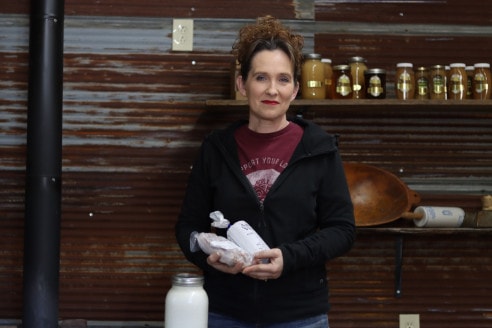
Now, consumers need to be more conscious of what they’re buying. The easiest way is to find a local producer who will answer questions.
“We’ve always done it out on pasture,” Saunders said. “Around here in northeast Kansas, there’s grass, but there’s not that much grass. And urban encroachment is a real thing.”
Saunders would have to either supplement production with a lot of hay and forage or find more land to rotate her cattle around if she wanted to feed grass only.
“If you’ve got the grass to completely do it, that’s great,” Saunders said.
She has raised high quality beef, pork, chicken and dairy cows on her farm just north of Lawrence, Kansas, for more than 20 years. Her livestock is always out on pasture, but with the option to eat grain.
“I’ve never had any of my animals turn me down,” Saunders laughed. “But they’re not standing there at it (the feeder) all the time doing nothing but eating — and we’re not forcing them to.”
The animals still graze and harbor nutrients from the pasture around them.
For Saunders, it was a matter of what she felt worked best for her operation. She wanted to buy out of her local farmers’ fields, and in an area where farmland is increasingly shrinking, it would be difficult to locally source the amount of hay and forage she would need to sustain her cattle through the winter.
So she buys high quality, local grain to offer them instead.
“That to me is better, because I’m literally putting that money back into my community,” Saunders said.

Plus, Saunders, and many consumers, prefer the taste of a grain-finished meat.
Like New, Saunders does things the “slow way,” letting nature work its way back. Right now, her hogs forage through the wooded areas on the property, clearing away some of the tree coverage so that native grasses can come back to that soil.
“There’s room for everybody… As an industry, we cannot pit ourselves against each other,” Saunders said. “(Because) there are not enough producers right now to locally feed your community.”
Her advice to consumers is to assess what they need, what they can afford and what they have access to.
“Dan, (her husband) and I try really, really hard to always focus on the actual person — what their actual needs are,” Saunders said.
If someone needs a lean cut of beef, she’ll direct them to a grass-fed seller. It’s all part of building back an interconnected, local food system.
New sees the local system coming back too, and it’s something he actively works to build.
“Develop a relationship, find out where your food comes from, ask questions,” New said.
He believes change will come from the bottom via consumer support and top down through government programs and incentives.
“Consumers need to become conscientious of where their food comes from,” New said. “And I think we’re starting to witness the beginning of localization coming back … It’s going to look different, but I do see it coming back.”
Cami Koons covers rural affairs for Kansas City PBS in cooperation with Report for America. The work of our Report for America corps members is made possible, in part, through the generous support of the Ewing Marion Kauffman Foundation.



